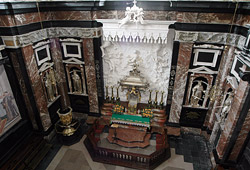The Chapel of St Casimir
Upon entering the chapel, one’s gaze immediately falls on the altar and its surroundings. The focal point of the altar composition, and indeed, of the entire chapel, is the sarcophagus containing St Casimir’s remains. The current coffin casing was made in the middle of the 18th century. Above it is a sculpture of the saint, solemnly enthroned, which was probably part of an earlier coffin. Very few relics of St Casimir exist elsewhere. Some were given in the mid 17th century to St Casimir’s Church in Vilnius and the Church of St George in Naples. At the Basilica of St Lawrence in Florence, his relics are kept in an ornate reliquary labelled “St Casimir, Grand Duke of Lithuania”.
In between the sarcophagus and the tabernacle, which dates to 1837, the old portrait-style, three-handed image of St Casimir has been installed. The wall behind the altar is adorned with stucco decoration. At the crest of the baldachin, two small angels hold up a crown. Centred just below the baldachin is a unique stucco representation of the Blessed Virgin Mary, smiling and holding the Child Jesus in her arms. Niches in the walls of the chapel contain eight silver-plated wooden statues of political leaders. When they appeared and whom exactly they represent is not known with certainty. They are thought to date to the late 17th and early 18th centuries, and to represent rulers of the Jogailaitis dynasty, relatives of the holy Prince Casimir. At the end of the 19th century, plaques commemorating the dynasty members who are buried in the Cathedral were installed at the base of the sculptures. Among the chapel’s most significant decorative accents are two large wall frescos by Michelangelo Palloni (1637–1712). They portray miracles after St Casimir’s death, which confirmed his sanctity in a visible way.
To the left of the altar stands a pulpit of gilded wood, installed in the late 17th or early 18th century. Frescos on two sections of the dome are attributed to Michelangelo Palloni. The other two were painted by Pranciškus Smuglevičius at the end of the 18th century. Deep niches inside the cupola of the dome, above the frescos, guard sculptures of the four cardinal virtues: justice, fortitude, prudence and temperance. The cupola, which represents the heavens, has little ornamentation, although its zenith features a metal dove – a symbol of the Holy Spirit.








